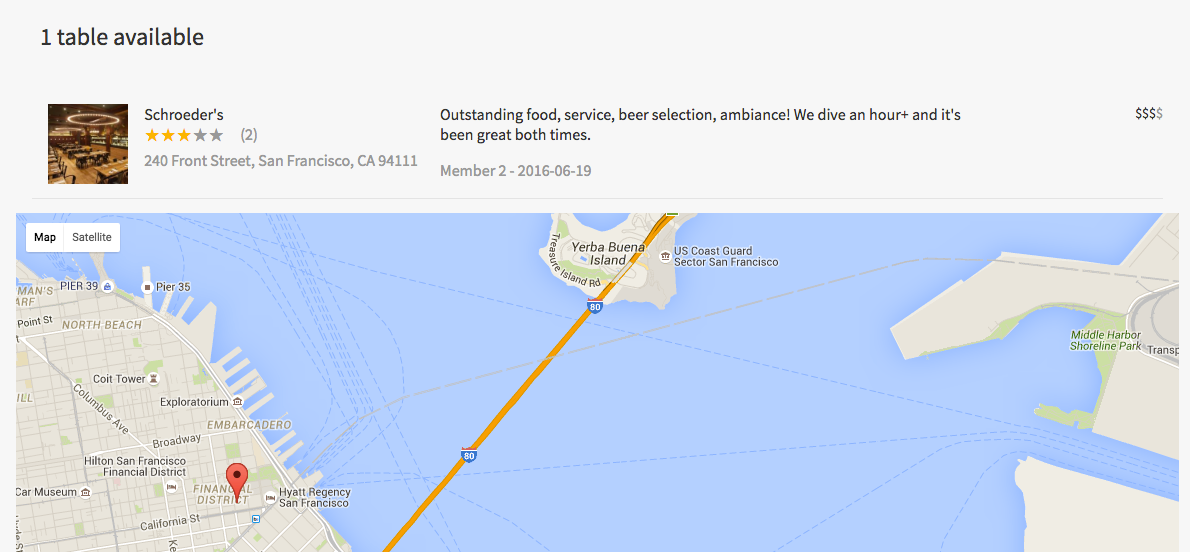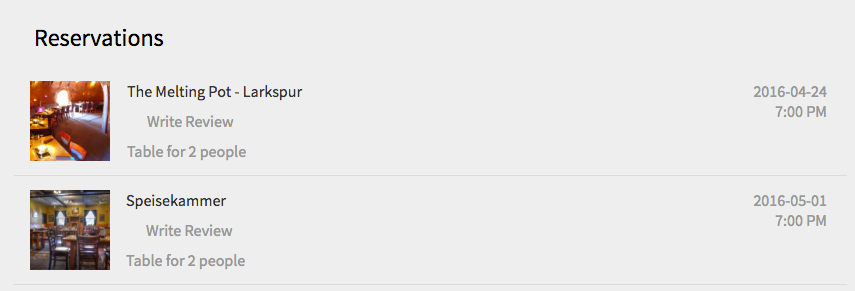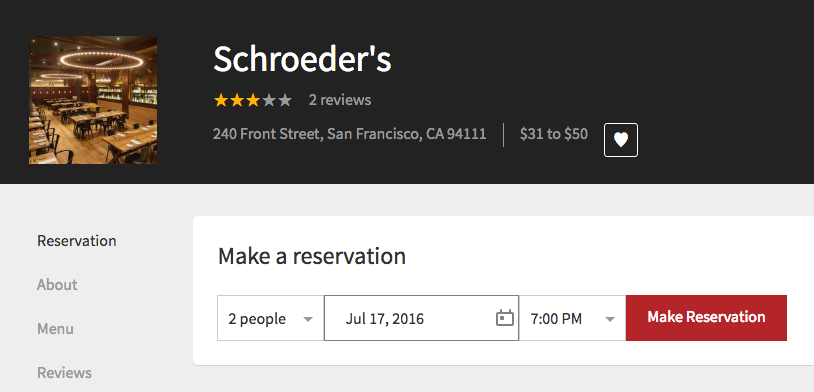Tafelspitz demonstrates an online real-time restaurant reservation service. It specializes in Restaurants with German and Central-European cuisine in the San Francisco Bay Area (seed database). The database can be searched through criteria entered in the search bar or by map location: by default all restaurants within the area displayed on the root page map are listed. The list is updated whenever the map view changes (zoom or translation).
Tafelspitz allows users to search for restaurants and reservations based on parameters including times, dates, location and price range. Users who have registered their email address with the system receive a confirmation of their reservation. They can review restaurants they have visited and rate them based on food, service, ambience, and value. They can maintain a list of their favorite restaurants.
Registered users can add their own restaurants to the database to manage their reservations (RESTAURATEUR button in the footer section). They have to provide at a minimum the name and address of the restaurants and a description with price range and an optional menu. The system also handles opening times and seating capacity. Although the purpose of the service is to show German cuisine in the San Francisco Bay area, Tafelspitz does not limit additions to its database by geography or menu.
For demonstration purposes, the reservation scheduler makes the following simplifying assumptions: their is only one continuous opening period per day (all day by default) that does not vary with date or day of the week, seating capacity is fixed (unlimited by default), booking time slots are fixed to 30 minute intervals. The search function is limited to restaurant names at this time, although any other piece of information in the database could easily be exploited. The search field presents the user with a list of matching restaurants (any part of the name can be matched). The "View all listed restaurants" link removes all previous filters (including the map window).
The "Find a Table" search will filter the restaurant listing by the criteria selected in the search bar, defaults apply to unselected criteria. The analogous "Make Reservation" search bar on each restaurant's show page registers a reservation with the selected parameters in the user's account.
Tafelspitz (German, literally meaning tip (of meat) for the table) is boiled veal or beef in broth, served with a mix of minced apples and horseradish. It is considered to be one of the many national dishes of Austria and is equally popular in the neighboring German state of Bavaria ([Wikipedia Reference][reference]). [reference]: https://en.wikipedia.org/wiki/Tafelspitz
This application is inspired by Opentable (check it out through the DISCOVER link).
The Tafelspitz application is built on a Ruby on Rails backend and a React.js Flux pattern architecture frontend.
At the core is a PostgreSQL object-relational database system. The data are organized into tables for users, restaurants, reservations, reviews, and a favorites join table that connects users and their favorite restaurants. Login and sign up are controlled by a sessions controller. The database is seeded with actual information from German restaurants in the San Francisco Bay Area. Guest login is handled through a seeded guest user account.
The user access control is managed through the users and session controllers through BCrypt password encoding. Session tokens keep track of the currently logged in user.
The restaurant and reservation tables form the center of this application. New restaurants are generated through a frontend form. Their location is determined from their address with help of the Google Map API:
def self.address_to_coords(address)
query = "select *"
url = "https://maps.googleapis.com/maps/api/geocode/json?address="
url.concat(address.split.join("+"))
api_key = "&key=#{ENV['gmap_key']}"
url.concat(api_key)
uri = URI(url)
response = Net::HTTP.post_form(uri, { query => nil })
body = JSON.parse(response.body)
body["results"][0]["geometry"]["location"]
endThe API key is secretly stored in a YAML database file. The same API is used to filter the restaurant database based in geographical coordinates within the map window displayed in the browser and controlled by the user.
Reservations are organized under their restaurant route and serve as the second filter for the restaurant table:
def self.available(list, params)
unfiltered = params[:filter].start_with?("f") ? true : false
name_known = !!params[:name] && params[:name].length > 0
return list if list.empty? || unfiltered
time = Reservation.time_slot_to_time(params[:time_slot].to_i)
guest_count = params[:guest_count].to_i
filtered = []
if name_known
filtered = self.where("opening < ?", time)
.where("closing > ?", time)
.where("seats > ?", guest_count)
.where("name = ?", params[:name])
else
filtered = self.where("opening < ?", time)
.where("closing > ?", time)
.where("seats > ?", guest_count)
end
return filtered if filtered.empty?
reservations = Reservation.where("date = ?", params[:date])
.where("time = ?", time)
avail = []
filtered.each do |restaurant|
taken = reservations.inject(0) { |res, table| res + table.guest_count }
avail << restaurant if taken + guest_count <= restaurant.seats
end
avail
endDatabase associations with the reservations, favorites, and reviews tables are used to streamline database AJAX queries from the frontend.
Restaurants are classified by a four-point :price_range scale.
Reservations are the only model that allows all standard Rails controls
of creation, show, editing, and deletion. The model provides a simplified,
basic set of properties: :date, :time, :guest_count, as well as a
catch-all text property :requests. The booking time is represented by
half hour time slots between single Restaurant.opening and Restaurant.closing
times. The :guest_count may not exceed the Restaurant.seats capacity.
Foreign keys :guest_id and :restaurant_id link reservations to the users
and restaurants tables.
The review model is analogous to the reservation model (linked to both users
and restaurants through foreign keys), but the controller only allows to
create, not to edit or destroy reviews. Its properties are overall and
categorical ratings on a five-point "star" scale and a review text: :rating,
:rate_food, :rate_ambience, :rate_service, :rate_value, and :body.
The relationship of users liking particular restaurants is expressed as a simple join table on the backend and a toggle on the frontend:
class Favorite < ActiveRecord::Base
validates :user_id, :restaurant_id, presence: true
validates :user_id, uniqueness: {scope: :restaurant_id}
belongs_to :restaurant
belongs_to :user
endAs views are handled on the frontend, they are rendered as JSON objects by the Rails controllers. Restaurants are associated with reservations, reviews, and favorites that are rendered together in the browser. The controllers, therefore, query the database through joins and use JBuilder to create customized JSON objects in response to AJAX requests from the frontend:
json.extract! restaurant, :id, :name, :description, :lat, :lng,
:img_url, :price_range, :address, :phone, :menu, :average_rating,
:count_rating
json.fans restaurant.fans.map(&:id)
json.reviews restaurant.reviews.map { |review| review }The root page is divided into three main components:
a header containing
the logo  , which serves as a link
back to the root page and resets user filters, and the user handling
logic of sign up, login, user page navigation, and logout;
, which serves as a link
back to the root page and resets user filters, and the user handling
logic of sign up, login, user page navigation, and logout;
a content section with the main search bar, restaurant listing, and map control component;
a footer with links to the original website, the README, and the restaurant entry form for restaurateur users.
User and show pages for individual restaurants follow the same organization into header, main content, and footer.
There are two different content sections for the user pages: reservations and review form links reached from the profile and review menu items, and favorites, which modify the root restaurant items listing by filtering out the user's favorites and replacing the review display with a reservation link.
const RestaurantIndex = React.createClass({
render() {
let heading = "No Availability";
const restaurants = this.props.restaurants;
const restaurantKeys = Object.keys(restaurants);
let ent = " tables";
if(!restaurants || restaurantKeys.length < 1) {
return (
<div>
<div className="section-header">{heading}</div>
<div className="section"></div>
</div>
);
}
if (restaurantKeys.length === 1) {
ent = " table";
}
if (this.props.filter === "favorites") {
heading = "Favorites"
} else {
heading = restaurantKeys.length + ent + " available";
}
return (
<div>
<div className="section-header">{heading}</div>
<div className="section">
{
restaurantKeys.map( key => {
return (<IndexItem
filter={this.props.filter}
restaurant={restaurants[key]}
key={key} />);
})
}
</div>
</div>
);
}
});The restaurant show page content consists of a summary header and a list of sections: Make reservation, About the restaurant with a static location map, menu, and reviews listing. A sidebar with fixed positioning provides links to each section.
Frontend dataflow is organized into the following React flux pattern cycles of view -> action -> dispatcher -> store:
Session handling login/logout and the favorite toggle for the current user,
Restaurant handling display of restaurant information based on
Filter parameters entered via search bar, Google map, and like buttons,
Reservations and Reviews are dispatched to and retrieved from the database under the associated restaurantID route.
The live map on the root page is implemented with the Google Map API. It controls the restaurant display based on the the displayed map window. It triggers the bounds filter actions that update the restaurant store from the database. Restaurant markers are dynamically generated and removed. Clicking on a marker brings up the associated restaurant show page. The Google Map API also provides the static map display on the show pages.
User entry forms and alert messages are realized as react-modal components that interrupt the normal interaction flow. There are entry forms for sign up, login, new restaurants, and reviews. Inside the search bars time slot and guest number selection are implemented as react-select drop-down menus, the calendar date picker uses a react-date-picker DateField component. The name search field returns a list of matches from the Flux restaurant store.
Modal alert forms are triggered when users try to access content reserved for registered users (this includes the guest account for demo purposes): reservations, reviews, favorites, and new restaurants.
Passive (display) and active (reviewer input) star ratings are implemented as react-star-rating-components.
I am planning to improve and expand this project in the future. Here are some of the next steps
auto-complete search extended to cities (culled from address); drop-down menu selection for price range and ratings
containing a unique list of visited restaurants to be reviewed rather than individual reservations. Users could be restricted to one review per restaurant. Nickname should be consistent between reviews by the same user.
keeping track of cumulative reservations per time slot
expanding database columns to allow for variable opening times
suggesting alternative availability within a given time window
using structured entry form for menu to allow customized rendering on the restaurant show page






